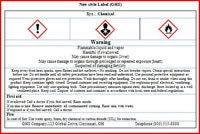Category: Chemicals
Today’s workplace uses thousands of chemicals, many of which are hazardous. The resources in this section will help guide you in the safe and legal identification, storage, transport, and use of these chemicals, and in making sure that your employees right to know how to be safe around such substances is provided, as required by law.
It’s time to start thinking about training on the new safety data sheet (SDS). Here are some ideas to get you started, and a great new BLR product to help you train. OSHA estimates that over 5 million workplaces in the United States would be affected by the revised hazard communication standard. These are all […]
Ready for the new GHS-required safety data sheet (SDS)? Here’s a little game of 20 questions to test your knowledge of the new SDS. Use the quiz to check supervisors’ understanding of the new format as well. Although you still have over a year to train employees about the new GHS-required SDS and even more […]
Premanufacture notices SNURs are directly connected and sometimes identical to TSCA premanufacture notices (PMN) consent orders the EPA develops for new chemicals. Through PMN consent orders, the EPA imposes conditions and restrictions on the manufacture, processing, and distribution in commerce of new chemicals. After development of a PMN consent order, the EPA will issue an […]
President Obama’s Omnibus Appropriations Act rescinded EPA’s TRI Burden Reduction Rule of 2006. The Act requires that all reports on PBT chemicals (chemicals and chemical categories of “special concern”) be submitted on Form R, the more detailed form. For all other chemicals, the shorter Form A may be used only if the annual reporting amount […]
Why do we need the GHS? GHS is a Globally Harmonized System of classification and labeling of chemicals, yet we already have OSHA’s hazard communication standard (HCS), so why is GHS necessary? In a BLR webinar titled "The Hazard Communication Standard: Significant Changes are Finally Here – Are You Ready for GHS?," Brad Harbaugh outlined […]
Use Exemptions Certain uses of listed toxic chemicals are exempt: Use as a structural component of the facility. Use in routine janitorial or facility grounds maintenance (including phenol in bathroom disinfectants and pesticides in lawn care products). Listed chemicals used in facility equipment maintenance and cleaning or maintenance activities that are integral to the production […]
Today, we’ll look key requirements of the new GHS labeling system New labels required by the revision of the hazard communication standard (29 CFR 1910.1200) to incorporate GHS amendments will look and read somewhat differently from previously approved label formats. Of course the purpose of the new labels, tags, and markings remains as always to […]
With the hazard communication standard already a regular fixture on OSHA’s most frequently cited standards list, it’s more important now than ever before to understand how GHS affects your hazard communication obligations. It’s important to remember that your hazard communication requirements will not be reduced by the Globally Harmonized System (GHS); they will simply be […]



